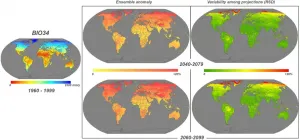Understanding future species distribution: new data for biogeographers
2021-01-14
(Press-News.org) Climate change impacts, affecting primarily ecosystems' functions and consequently human sectors, have become a crucial topic. Observed and expected variations in climate conditions can in fact undermine the ecosystems' ecological equilibrium: average climate patterns, mainly represented by intra-annual (monthly to seasonal) temperature and precipitation cycle, directly influence the distribution, abundance and interactions of biological species.
During the long history of scientific research on the relationships between climate and Earth's communities, numerous meteorological variables and/or derived indices have been formulated, calculated and applied to explain the geographic distribution of natural populations along climate gradients, characterized by intra-annual patterns of temperature and precipitation. Such variables and indices are also known as bioclimatic indicators (BioClimInd). They mainly result from primary - observed or modelled - climate fields (e.g. minimum, maximum and mean temperature, precipitation amount) and contribute to delineate the bioclimatic "envelope" for species in terms of favourable environmental conditions, also referred to as "suitability.
A study led by the CMCC Foundation and recently published on the Nature Journal Scientific Data released a new global and free access dataset of bioclimatic indicators at 0.5° by 0.5° spatial resolution (ca. 50 km at the equator) for historical and future conditions. "Our target was to widen the availability of bioclimatic information by an ensemble of bioclimatic indicators valuable both for historical and future robust climate change impacts' assessments", explains Sergio Noce, CMCC scientist and lead author of the study. His research at CMCC focuses on the analysis of the potential impacts of climate change on spatial distribution of forest species. "We're thinking about a wide range of research fields such as wildlife ecology, natural resources' conservation and management, botanic, forestry and many other fields involving biogeography. More in general, our data could be useful for all studies using species distribution modelling. Considering its spatial resolution, this dataset will be especially suitable for studies at continental - global scale, for example, to study regions such as the Mediterranean or the Russian territory; even before releasing the dataset, our team published a work on the impacts of global warming on Russian forests from a biogeographical perspective using these bioclimatic indicators".
What is meant by biogeography and why bioclimatic indicators are so important? As he explained in his Nature Behind the paper article, "Biogeography studies the distribution of species and ecosystems in a geographic space and the relationships between these communities and, among others, the climatic conditions: bioclimatic indicators summarize these conditions. Changes in species distribution has always occurred; there are many examples of animal or plant species that 'migrated' towards more suitable environmental and climatic conditions in the past. To make an example, starting from the end of the most recent glaciation (approx 11-12,000 years B.P.) the European hazel were only in some glacial refugia in southern Europe; as climate was getting warmer, hazel started to migrate north and spread in all the European continent. Climate change accelerated this processes and today understanding and being able to forecast future climate envelopes, that is understanding how species distribution and occurrence will change in the future, is becoming always more important."
The new dataset, called CMCC-BioClimInd, will contribute to achieve this goal while providing a set of 35 bioclimatic indices calculated both for a 40-years historical interval (1960-1999) and for two future time horizons (mid-term 2040-2079 and long-term 2060-2099) from, respectively, post-processing of climate reanalysis and an ensemble of 11 Coupled Model Intercomparison Project Phase 5 (CMIP5) bias corrected climate simulations.
Therefore the new CMCC dataset of bioclimatic indicators will be useful to a broad community of researchers aiming at reproducing and modelling, respectively, current and future habitats' ranges by mean of a Species Distribution Modelling (SDM) approach, where large amount of high quality and up-to-date environmental (especially climate) data is required.
"On the one hand", Noce concludes, "the exploitation of indicators instead of just raw climate variables enables easier inferring of relationships between the studied topic (species occurrence, resources availability etc.) and the climate regime to support decision for complex systems; on the other hand, using the ensemble allows considering the variability across simulations due to the different models' physics and the uncertain future development pathways."
The work is ongoing and in the near future, CMCC researchers wish to keep CMCC-BioClimInd up-to-date adding more climate simulations and/or further model outputs.
The data of individual indicators are publicly available for download in the commonly used Network Common Data Form 4 (NetCDF4) format in CMCC Data Delivery System (CMCC DDS) just released online, a unique, consistent and seamless access point for all data produced and used by CMCC.
INFORMATION:
For further information, read the full version of the paper:
Noce, S., Caporaso, L. & Santini, M. A new global dataset of bioclimatic indicators. Sci Data 7, 398 (2020). https://doi.org/10.1038/s41597-020-00726-5
[Attachments] See images for this press release:

ELSE PRESS RELEASES FROM THIS DATE:
2021-01-14
BIRMINGHAM, Ala. - Use of the diabetes drug metformin -- before a diagnosis of COVID-19 -- is associated with a threefold decrease in mortality in COVID-19 patients with Type 2 diabetes, according to a racially diverse study at the University of Alabama at Birmingham. Diabetes is a significant comorbidity for COVID-19.
"This beneficial effect remained, even after correcting for age, sex, race, obesity, and hypertension or chronic kidney disease and heart failure," said Anath Shalev, M.D., director of UAB's Comprehensive Diabetes Center and leader of the study.
"Since similar results have now been obtained in different populations from around the world -- including China, France and a UnitedHealthcare analysis -- this suggests that the ...
2021-01-14
Ignoring a colleague's greeting or making a sarcastic comment in the workplace may actually do more harm than intended, according to West Virginia University research.
Perceived low-grade forms of workplace mistreatment, such as avoiding eye contact or excluding a coworker from conversation, can amplify suicidal thoughts in employees with mood disorders, based on a study by Kayla Follmer, assistant professor of management, and Jake Follmer, assistant professor of educational psychology.
"We know from prior research that minor forms of workplace mistreatment reduce employee engagement," Kayla Follmer said. "But our paper provided an explanation for ...
2021-01-14
New York, NY (January 14, 2020) -- Girls who are emotionally neglected or severely sexually abused early in their lives report riskier sexual behaviors during adolescence, Mount Sinai researchers report. The findings highlight the need--and suggest the potential for tailored approaches--to promote healthy sexual development in vulnerable populations.
The researchers identified four distinct patterns of neglect and sexual abuse in low-income, predominantly Black and/or Latina girls and young women that led to distinct trajectories of risky sexual behavior during adolescence. Their findings were published in Child Development in January.
The study was the first of its kind to identify categories of maltreatment among adolescent girls of color in an urban setting that correspond with measurable ...
2021-01-14
The COVID-19 pandemic, which claimed more than 336,000 lives in the United States in 2020, has significantly affected life expectancy, USC and Princeton researchers have found.
The researchers project that, due to the pandemic deaths last year, life expectancy at birth for Americans will shorten by 1.13 years to 77.48 years, according to their study published Thursday in the Proceedings of the National Academy of Sciences.
That is the largest single-year decline in life expectancy in at least 40 years and is the lowest life expectancy estimated since ...
2021-01-14
A team of biophysicists from the University of Massachusetts Amherst and Penn State College of Medicine set out to tackle the long-standing question about the nature of force generation by myosin, the molecular motor responsible for muscle contraction and many other cellular processes. The key question they addressed - one of the most controversial topics in the field - was: how does myosin convert chemical energy, in the form of ATP, into mechanical work?
The answer revealed new details into how myosin, the engine of muscle and related motor proteins, transduces energy.
In the end, their unprecedented research, meticulously ...
2021-01-14
Humans, mammals and birds that live in a particular environment share a common set of behavioral traits, according to a new study, which identifies a local convergence of foraging, reproductive and social behaviors across species. The findings, based on studying more than 300 small-scale human hunter-gatherer populations, support one of the central tenets of human behavioral ecology - that ecological forces select for various behaviors in distinct environments, driving behavioral diversity worldwide. The origin and evolution of human behavior are uncertain and debated. While some suggest ...
2021-01-14
The volatile plant hormone ethylene allows plant roots to sense and avoid compacted soils, researchers report. Rendering roots insensitive to ethylene allowed them to penetrate compacted soils more effectively, the same group showed. The findings reveal how plants regulate their growth in response to soil compaction - a growing challenge facing modern agriculture worldwide - and could serve as a pathway for how breeders might select or develop new crops resilient to soil compaction. Driven in part by a growing reliance on heavy machinery and poor soil management practices, soil compaction can lead to declining crop yields by restricting root growth and limiting the availability ...
2021-01-14
A large class of mammalian genes is not completely shared throughout sperm development and differentiation, according to a new study of sperm in organisms including mice, macaques and men. The findings provide an explanation to why testis gene expression patterns often appear as an outlier relative to all other tissues. In mammals, spermatogenesis includes a long stage of haploid gene expression, which could lead to variation between individual sperm cells, resulting in sperm-level natural selection and trait inheritance. However, during differentiation, maturing haploid spermatids ...
2021-01-14
Foraging humans find food, reproduce, share parenting, and even organise their social groups in similar ways as surrounding mammal and bird species, depending on where they live in the world, new research has found.
The study, published today in Science, shows environmental factors exert a key influence on how foraging human populations and non-human species behave, despite their very different backgrounds.
The team of international researchers analysed data from more than 300 locations around the world, observing the behaviours of foraging human populations ...
2021-01-14
Scientists have discovered a signal that causes roots to stop growing in hard soils which can be 'switched off' to allow them to punch through compacted soil - a discovery that could help plants to grow in even the most damaged soils.
An international research team, led by scientists from the University of Nottingham's Future Food Beacon and Shanghai Jiao Tong University has discovered how the plant signal 'ethylene' causes roots to stop growing in hard soils, but after this signal is disabled, roots are able to push through compacted soil. The research has been published in Science.
Hard (compacted) soils represent a major challenge facing modern agriculture that can reduce crop yields over 50% by reducing root growth, causing significant losses annually. Europe has over 33-million-hectares ...
LAST 30 PRESS RELEASES:
[Press-News.org] Understanding future species distribution: new data for biogeographers



